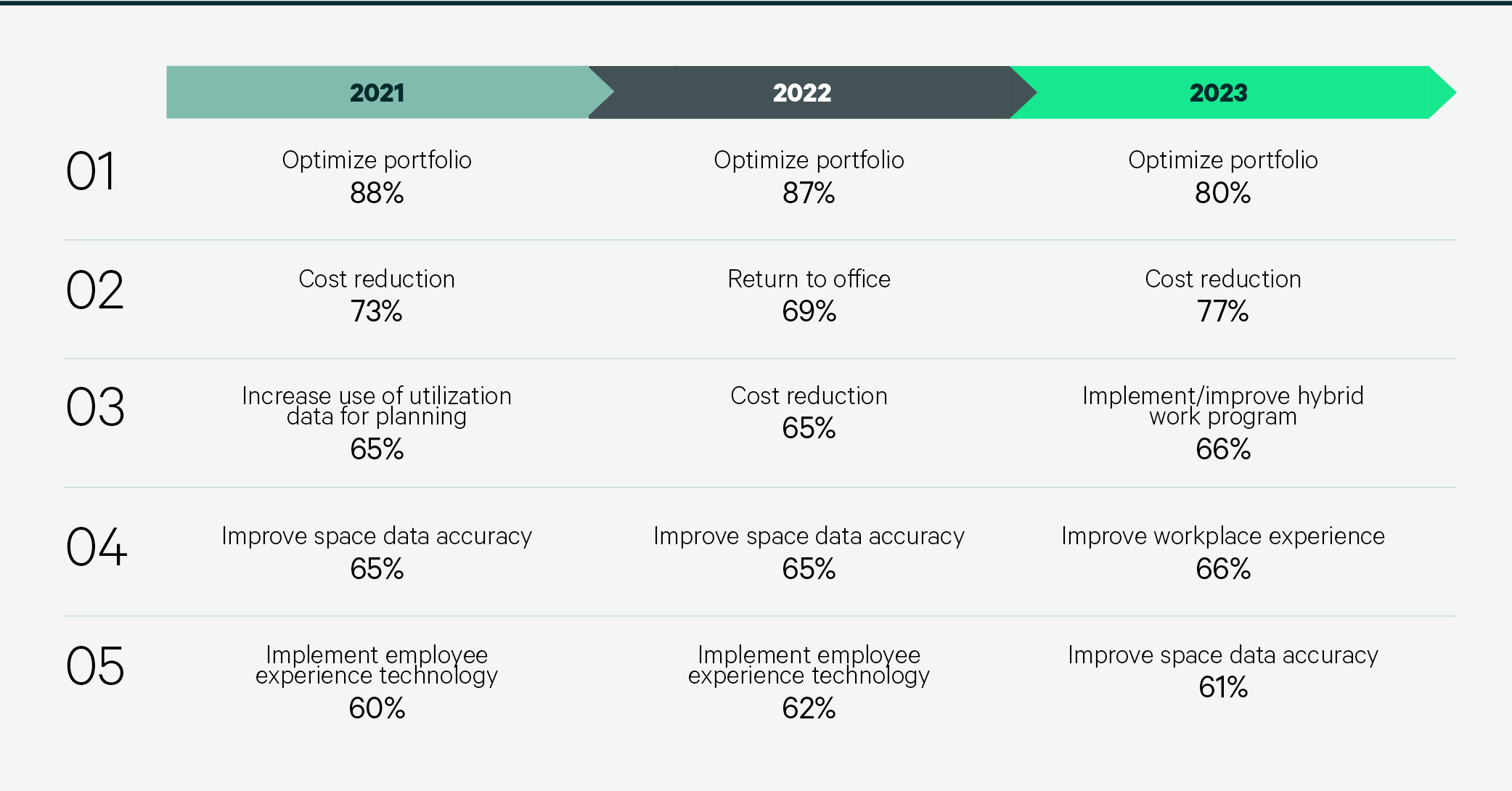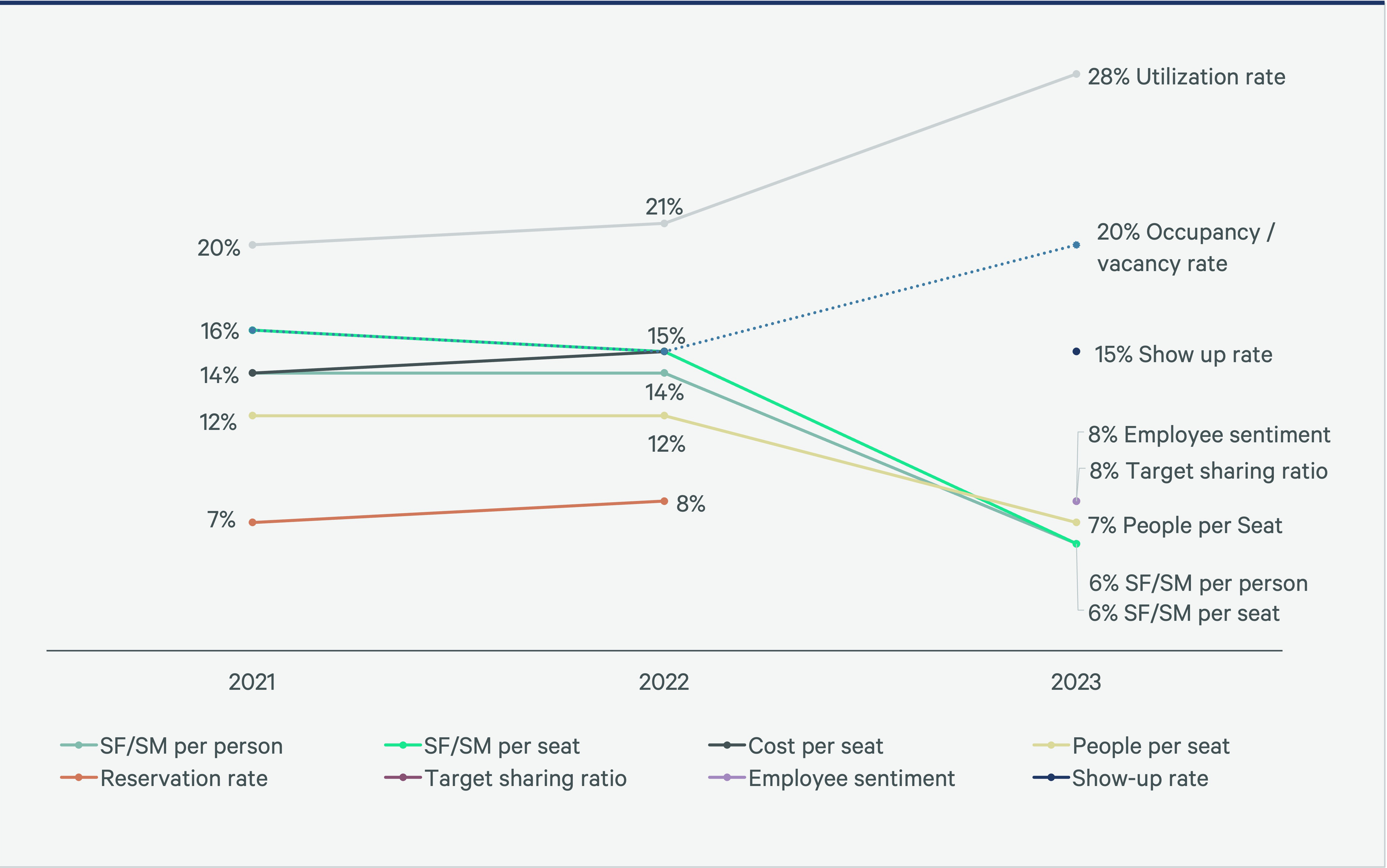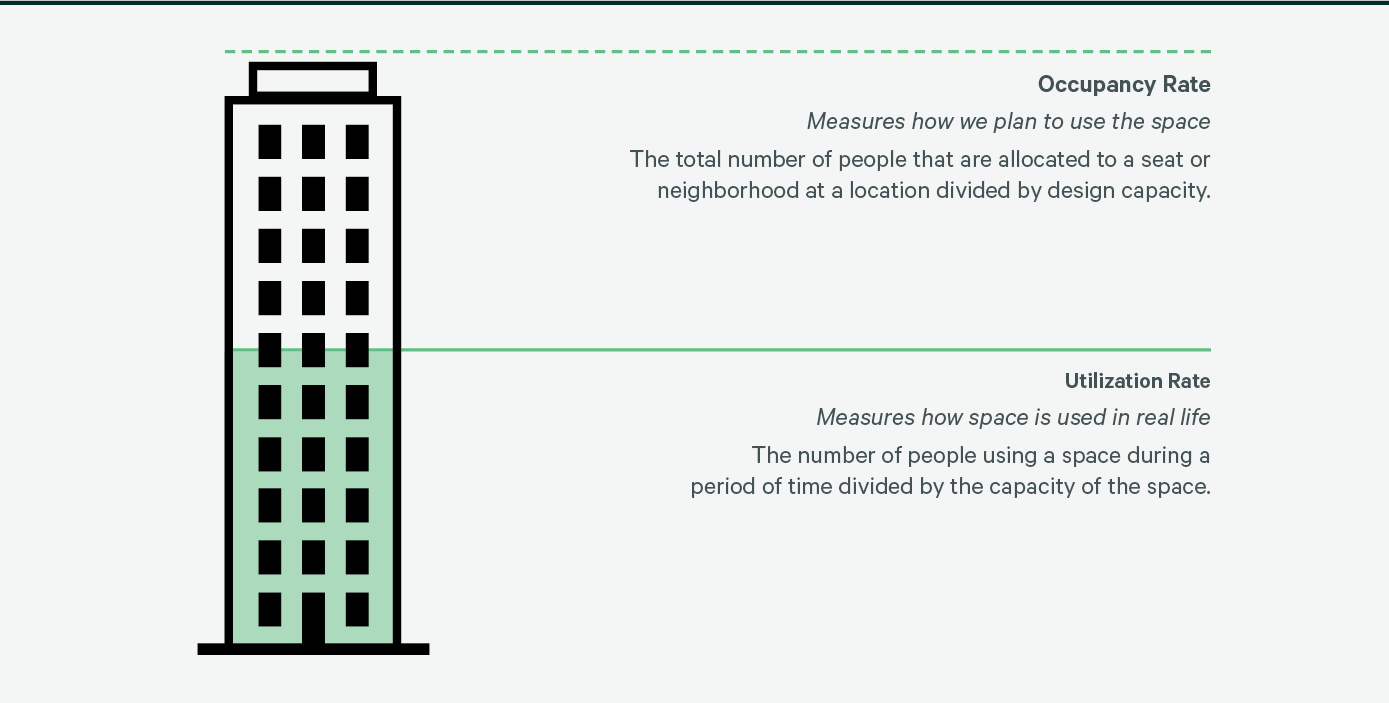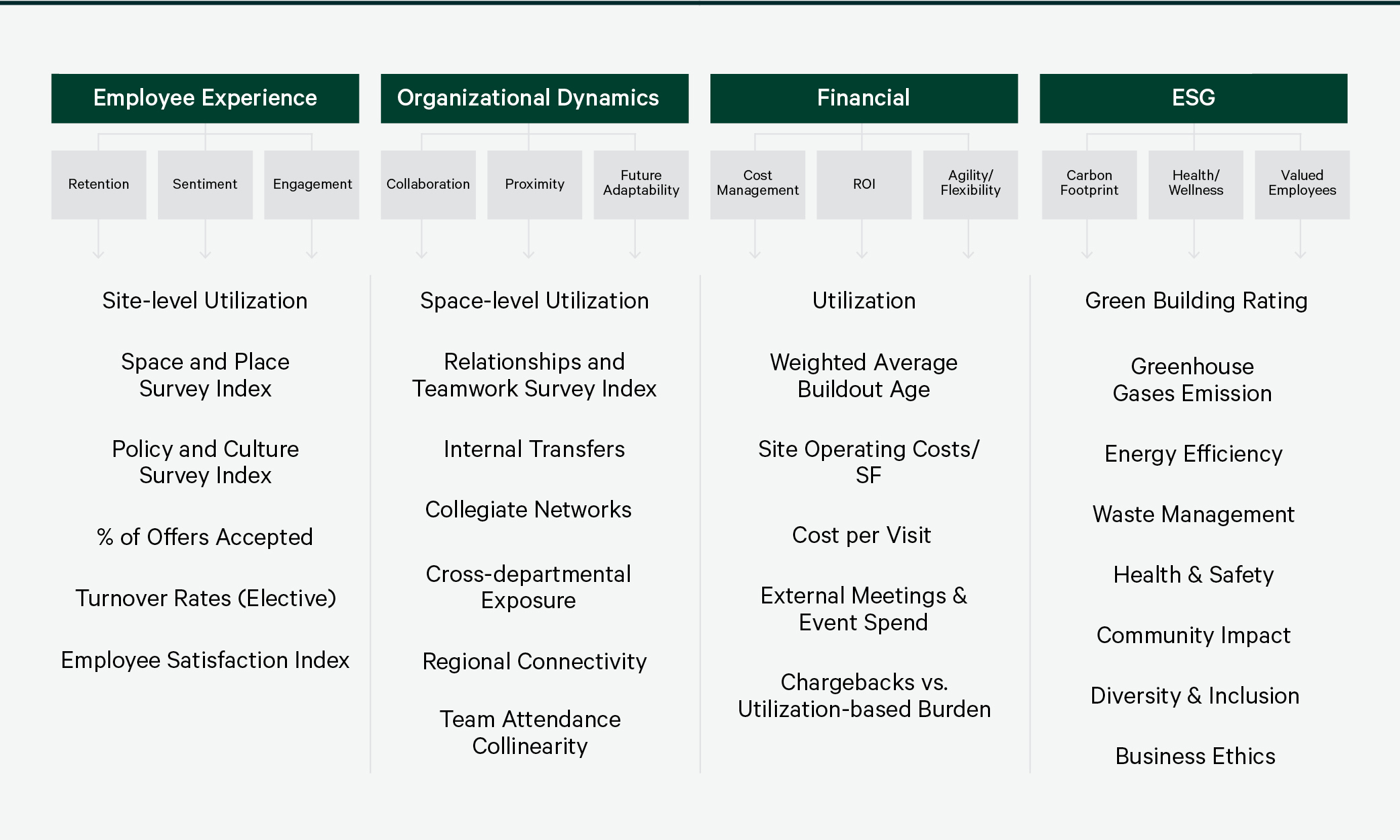Chapter 4
Measuring Workplace Effectiveness
2023–2024 CBRE Global Workplace & Occupancy Insights
5 Minute Read
Portfolio Optimization Remains the Top CRE Goal
There have been few changes to CRE goals over the last three years. Portfolio optimization and cost reduction have remained top objectives for corporate real estate teams who are focusing on two strategies to achieve these goals: 1) increasing space-sharing and 2) eliminating underutilized space. 86% of participants plan to dispose of underutilized space to reduce costs, while 75% will do it to optimize the portfolio. 76% of participants plan to increase space-sharing to reduce costs, while 82% will do it to help optimize the portfolio.
One exception, however: in 2023 we saw an increased emphasis on hybrid working and workplace experience goals supplant an earlier focus on simply returning employees to the office. This focus reflects the evolution of the workplace from a managed expense to a valuable asset in the competition for talent. As a result, CRE leaders who were once focused on making the portfolio efficient are now challenged to also make the workplace experience more effective.
Figure 22: Top Five Goals of CRE Teams from 2021-2023

What really is changing in placemaking is this mindset of thinking less about employees as somebody that you transactionally provide accommodation to, but rather thinking about them as a consumer of an experience that you host and curate for them on site.

The New Occupancy Metrics That Matter Most
To address the shift from efficiency to effectiveness, CRE leaders have reprioritized the metrics that matter most and expanded their perspective from occupancy to the holistic workplace. While utilization rate remains the most important metric, planning metrics like sq. ft./sq. m. per person and sq. ft./sq. m. per seat have been replaced with workplace performance metrics such as employee sentiment and attendance or show-up rate.
Figure 23: Occupancy Metrics that Matter Most 2021-2023

For the first time, sq. ft./sq. m. per person and sq. ft./sq. m. per seat are no longer in the top 5 metrics that matter most
This reprioritization reflects the expansion of workplace metrics from measuring plans for space to measuring the reality of how space performs.
Figure 24: Workplace Metrics–Planning vs. Performing
As an example, consider the story told by the top two metrics: occupancy rate and utilization rate. Space-sharing has enabled global office occupancy rates over 100%, meaning there are more people assigned to an office location than there are workspaces at that location. But actual global space utilization rate remains under 40%, which means that despite how many people are planned to use an office location, less than 40% of the workspaces get used in real life. While increased planning efficiency enables portfolio optimization and eventual cost reductions, the more critical metric here is the low utilization rate that exposes an imbalance of space supply and demand: too few people using too much space. The operational and financial impacts of underutilized space remains a top concern for CRE leaders in 2023, illustrating the growing reliance on performance metrics such as utilization rate over planning metrics such as occupancy rate. The next step in the evolution of workplace metrics is to understand how effectively the workplace supports an organization’s goals.
Figure 25: Occupancy Rate vs. Utilization Rate

Space-sharing is working. Occupancy rates are over 100%, meaning that offices have more people than seats. Traditionally, offices have had more seats than employees but this has changed thanks to the mass adoption of hybrid planning concepts.
How to Measure Workplace Effectiveness
Workplace effectiveness measures how well the combined physical and digital work experience supports the unique business and cultural goals of an organization. By measuring the impact of the work experience on employee and business performance such as employee sentiment and talent retention, we can understand the true value and ROI of workplace investments.
To measure the effectiveness of the hybrid workplace, CBRE recommends a new balanced scorecard that moves beyond traditional real estate metrics (e.g. rentable sq. ft. or rentable sq. m. per person or cost per rentable sq. ft. or rentable sq. m.) to show the broader impact the workplace has on employee performance, business priorities and financial/ ESG objectives.
CBRE uses a tailored evaluation tool that connects the workplace to key drivers and demonstrates priorities across four areas:
Employee Experience: Curating a great employee experience is critical to driving employees to the office and overall engagement. However, measuring a successful experience in a hybrid environment goes beyond utilization metrics. Capturing employee sentiment and validating with recruiting/attrition metrics provides a more holistic view of worker satisfaction.
Organizational Dynamics: With employees continuing to view the office as a place for building relationships over individual work, strong organizational dynamics are imperative to driving office attendance and a well-connected workforce. Assessing how the space, policies and events drive employee interactions is critical to a successful workplace.
Financial: As organizations look to drive more efficiency and trim underutilized space in real estate portfolios, traditional financial performance metrics become less applicable. Evaluating the costs of curating a strong workplace experience and having a clear understanding of which elements have the best ROI will be the new key financial metrics.
ESG: Environmental, Social, and Governance considerations form the three main pillars of ESG. These pillars comprise a variety of interdependent issues, topics and themes. The growing focus on ESG has raised questions on how to adopt strategic measures to create a new definition of the workplace of the future.
This approach designs customized metrics based on an organization’s unique needs, resulting in a workplace scorecard specifically suited to that organization’s desired outcomes. Common priorities across global office occupiers include employee retention and engagement, organizational adaptability and resilience, financial cost management and ROI, carbon reduction, and employee wellness. A new workplace scorecard that considers these priorities may include metrics that have traditionally been held by other parts of the business such as HR or IT, including employee turnover rates, collegiate networks, expense of offsite meetings and community impact
Co-creating this scorecard with a cross-functional team of leaders and employees ensures the full impact of the workplace is understood across all stakeholders. This level of effort requires leadership support and advocacy, as well as the thoughtful integration of data across teams.
Figure 26: Example of a New Workplace Scorecard

Related Services
Leverage occupancy data to empower, anticipate and unlock opportunities within your portfolio.
- Plan, Lease & Occupy
Workplace Consulting
Build resilience, attract and retain talent, and foster connection and collaboration in your workplace.
- Transform Business Outcomes
Consulting
Gain comprehensive guidance on insightful, executable real estate strategies for both investors and occupiers.
- Plan, Lease & Occupy
Organizational Change & Transformation
Enabling organizations to achieve outcomes, improve performance and create change-ready cultures.
Related Insights
-
Brief | Creating Resilience
Three Office Occupancy Trends That Are Impacting Portfolio Strategy
September 1, 2023

CBRE’s 2023 Workplace & Occupancy Benchmarking Program has identified three trends across Occupancy Management clients.
-
Podcast | Adaptive Spaces
Where It’s At: Expert takes on creating the ideal office experience
June 27, 2023

Want a more engaged, productive workforce in the age of hybrid work? The key is rethinking the office with new design approaches, flexible space and an abundance of practical amenities. So say three workplace strategy experts—Industrious CEO Jamie Hodari and CBRE’s Lenny Beaudoin and John Stephens—in a discussion about the future of cities.
Authors
Susan Wasmund
Executive Managing Director, Americas Consulting | Global Occupancy Management







